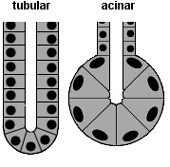 Epithelia
in which all the cells are specialized for secretion are usually
organized as the secretory portions of exocrine glands, which are
continuous with the non-secretory epithelia of ducts through which
the secreted product is discharged. The secretory cells and ducts
constitute the parenchyma or functional portion of the glandular
organ, while the connective tissue surrounding these epithelial
structures makes up the organ’s stroma. Epithelia
in which all the cells are specialized for secretion are usually
organized as the secretory portions of exocrine glands, which are
continuous with the non-secretory epithelia of ducts through which
the secreted product is discharged. The secretory cells and ducts
constitute the parenchyma or functional portion of the glandular
organ, while the connective tissue surrounding these epithelial
structures makes up the organ’s stroma.
Glands can be classified
structurally based on the structure of both the duct and the
secretory portion.
- Ducts can be branched (compound)
or unbranched (simple).
- The overall shape of glands’
secretory portions can be tubular, acinar (rounded), or
tubuloacinar (tubular with a rounded end).

- The secretory portion may also
be described further, as in branched tubular or coiled tubular
(i.e., long and not branched).
What exactly is branched or not
branched in simple and compound glands respectively?
Try to distinguish the two significant parts of a gland: the
secretory unit (acinus or tubule) from the duct.
Study the following examples of
glands in some of these structural classifications.
|
Class of
gland |
Example |
|
Simple, tubular |
Lining of large intestine |
|
Simple, coiled tubular |
Sweat glands of skin |
|
Simple branched acinar |
Sebaceous glands of skin |
|
Compound, acinar |
Exocrine pancreas |
|
Compound, tubuloacinar |
Submandibular salivary gland |
Serous and
mucous elements of a gland. |